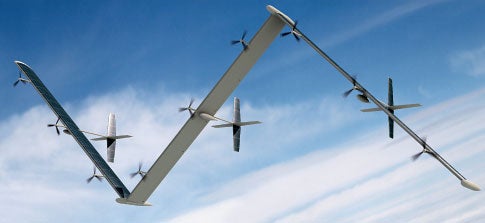Giant Solar Plane Will Stay Aloft for Five Years Straight
Odysseus, an autonomous surveillance-plane concept, will fly for years on end, powered by nothing but the sun

Nine days: That’s the longest any airplane has stayed in the air. Burt and Dick Rutan’s Voyager set the record in 1986 by flying 24,986 miles around the world without refueling. But nine days of uninterrupted flight won’t cut it for Darpa, the Pentagon’s advanced-research organization. It’s challenged the aviation industry to come up with an unmanned surveillance and communications plane that can circle targets for half a decade — and do so on nothing but solar power.
The aircraft you see here, Odysseus, was the first entry in the Vulture program, the competition Darpa created to make its extreme-endurance dreams come true. If the plane’s designers at Aurora Flight Sciences beat rival entries by Boeing and Lockheed — Darpa could pick a winner as early as this year — it will have the opportunity to make this concept into the real thing: a 492-foot-wide folding aircraft that can cruise at 140 mph at 70,000 feet for five years straight, powered by the solar panels that cover the top of the plane.
In fact, Odysseus is three planes in one, a collection of 164-foot-long wing-shaped constituent aircraft that take off separately and dock in the stratosphere, where the air is calmer and less stressful on the massive structure. (Aurora CEO John Langford says the company hasn’t chosen a docking mechanism yet but that it’s considering something based on the system that connected NASA’s Apollo command and lunar modules.) Each piece is interchangeable and can be swapped out in midair for repairs or upgrades. The three-piece construction allows Odysseus to autonomously change shape throughout the day to trap as much solar energy as it can. It could pleat like an accordion into a “Z” to absorb sunlight at low angles — at dusk, for example — and flatten into a more aerodynamically efficient traditional wing at night.
Catching as much sun as possible is essential, because energy — specifically, energy storage — is one of the biggest obstacles to solar flight, particularly solar flight that must continue without fail for years on end. Langford says Aurora is exploring storage methods, including flywheels, fuel cells and an array of batteries embedded throughout the airframe. The plane also needs to be light, so Aurora’s design relies on featherweight carbon composites. The huge craft could weigh in at under 7,000 pounds — approximately 2,000 pounds less than a fully fueled Voyager, which was less than a quarter of Odysseus‘s size.
Although it’s designed to be a surveillance platform, the lanky Odysseus would probably appear to the naked eye as a starlike glint, so it could be used for less-covert missions, such as patrolling a border or watching over suspected nuclear-reactor sites. And it could have civilian applications: Langford imagines it as an atmospheric buoy, monitoring storm development, climate change or the health of the ozone layer. Either way, he says, it would demonstrate the potential of solar power and serve as a testbed for green aircraft technology. “If we can build an airplane that can stay up for five years with nothing but sunlight,” he says, “what else can we do?”